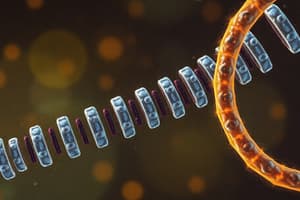Podcast
Questions and Answers
In eukaryotic cells, transcription cannot begin until?
In eukaryotic cells, transcription cannot begin until?
- Several transcription factors have bound to the promoter. (correct)
- The two DNA strands have completely separated and exposed the promoter.
- DNA nucleases have isolated the transcription unit.
- The DNA introns are removed from the template.
Which of the following is not true of a codon?
Which of the following is not true of a codon?
- It extends from one end of a tRNA molecule. (correct)
- It never codes for more than one amino acid.
- It consists of three nucleotides.
- It is the basic unit of the genetic code.
The anticodon of a particular tRNA molecule is?
The anticodon of a particular tRNA molecule is?
- The part of tRNA that bonds to a specific amino acid.
- Complementary to the corresponding mRNA codon. (correct)
- Changeable, depending on the amino acid that attaches to the tRNA.
- Catalytic, making the tRNA a ribozyme.
Which of the following is not true of RNA processing?
Which of the following is not true of RNA processing?
Which component is not directly involved in translation?
Which component is not directly involved in translation?
Which of the following mutations would be most likely to have a harmful effect on an organism?
Which of the following mutations would be most likely to have a harmful effect on an organism?
Flashcards are hidden until you start studying
Study Notes
Transcription in Eukaryotic Cells
- Initiation of transcription requires binding of several transcription factors to the promoter region.
- DNA strands must separate completely to expose the promoter, allowing for transcription to commence.
Codons
- A codon is a sequence of three nucleotides that codes for a specific amino acid.
- Each codon can only code for one amino acid, but multiple codons can specify the same amino acid.
- It is not true that a codon extends from one end of a tRNA molecule.
Anticodon Functionality
- The anticodon in tRNA is complementary to the corresponding codon in mRNA.
- This complementary pairing is crucial for accurate translation of mRNA into proteins.
RNA Processing
- RNA processing involves adding nucleotides to both ends of the RNA molecule and splicing by spliceosomes.
- Exons remain in the final mRNA, while introns are removed, contradicting the notion that exons are cut out.
- Ribozymes can play a role in the splicing of RNA.
Translation Components
- Translation involves mRNA, tRNA, ribosomes, and GTP, but not DNA, which is not directly involved in the translation process.
Mutations and Their Effects
- The most harmful mutation is a single nucleotide insertion close to the start of the coding sequence, as it can cause a shift in the reading frame, altering all subsequent amino acids.
- Other mutations, like a deletion of three nucleotides, may not have as catastrophic an impact due to potential reversion to the original reading frame.
Studying That Suits You
Use AI to generate personalized quizzes and flashcards to suit your learning preferences.




